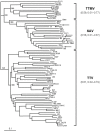Small Anellovirus in hepatitis C patients and healthy controls
- PMID: 16848049
- PMCID: PMC3291067
- DOI: 10.3201/eid1207.060234
Small Anellovirus in hepatitis C patients and healthy controls
Figures


Similar articles
-
Transfusion transmission of highly prevalent commensal human viruses.Transfusion. 2010 Nov;50(11):2474-83. doi: 10.1111/j.1537-2995.2010.02699.x. Transfusion. 2010. PMID: 20497515
-
[Chronic liver diseases associated with hepatitis G and TT viruses].Eksp Klin Gastroenterol. 2002;(1):66-71. Eksp Klin Gastroenterol. 2002. PMID: 12271589 Russian. No abstract available.
-
SEN virus detection in thalassemic patients infected with hepatitis C virus.Arch Virol. 2012 Dec;157(12):2441-5. doi: 10.1007/s00705-012-1443-3. Epub 2012 Aug 21. Arch Virol. 2012. PMID: 22907824
-
Torque teno virus (TTV): current status.Rev Med Virol. 2007 Jan-Feb;17(1):45-57. doi: 10.1002/rmv.524. Rev Med Virol. 2007. PMID: 17146841 Review.
-
[Molecular biology of TTV].Nihon Rinsho. 2004 Aug;62 Suppl 8:557-65. Nihon Rinsho. 2004. PMID: 15453383 Review. Japanese. No abstract available.
Cited by
-
Small anellovirus infections in Korean children.Emerg Infect Dis. 2007 May;13(5):791-3. doi: 10.3201/eid1305.061149. Emerg Infect Dis. 2007. PMID: 18044047 Free PMC article. No abstract available.
-
Torque Teno Midi Virus/Small Anellovirus in Sera of Healthy, HIV/HCV and HIV Infected Individuals in Lorestan Province, Iran.Jundishapur J Microbiol. 2015 Nov 21;8(11):e25368. doi: 10.5812/jjm.25368. eCollection 2015 Nov. Jundishapur J Microbiol. 2015. PMID: 26862377 Free PMC article.
-
Development of PCR assays with nested primers specific for differential detection of three human anelloviruses and early acquisition of dual or triple infection during infancy.J Clin Microbiol. 2008 Feb;46(2):507-14. doi: 10.1128/JCM.01703-07. Epub 2007 Dec 19. J Clin Microbiol. 2008. PMID: 18094127 Free PMC article.
-
Prevalence of anelloviruses (TTV, TTMDV, and TTMV) in healthy blood donors and in patients infected with HBV or HCV in Qatar.Virol J. 2016 Dec 28;13(1):208. doi: 10.1186/s12985-016-0664-6. Virol J. 2016. PMID: 28031027 Free PMC article.
-
Detection of Torque teno midi virus/Small anellovirus (TTMDV/SAV) in the sera of domestic village chickens and its vertical transmission from hen to eggs.Iran J Vet Res. 2015 Winter;16(1):110-3. Iran J Vet Res. 2015. PMID: 27175162 Free PMC article.
References
-
- Biagini P, Todd D, Bendinelli M, Hino S, Mankertz A, Mishiro S, et al. Anellovirus. In: Fauquet CM, Mayo MA, Maniloff J, Desselberger U, Ball LA, editors. Virus taxonomy, 8th report of the International Committee for the Taxonomy of Viruses. New York: Elsevier/Academic Press; 2004. p. 335–41.
Publication types
MeSH terms
LinkOut - more resources
Full Text Sources
Medical
